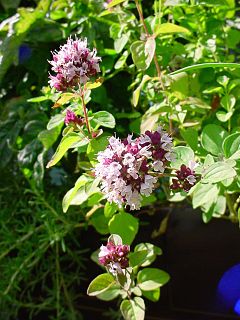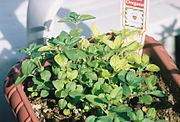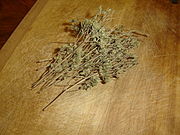
Oregano
Background Information
This selection is made for schools by a children's charity read more. To compare sponsorship charities this is the best sponsorship link.
| Oregano | |
|---|---|
 |
|
| Flowering oregano | |
| Scientific classification | |
| Kingdom: | Plantae |
| Division: | Magnoliophyta |
| Class: | Magnoliopsida |
| Order: | Lamiales |
| Family: | Lamiaceae |
| Genus: | Origanum |
| Species: | O. vulgare |
| Binomial name | |
| Origanum vulgare L. |
|
Oregano or pot marjoram (Origanum vulgare) is a species of Origanum, native to Europe, the Mediterranean region and southern and central Asia. It is a perennial herb, growing to 20-80 cm tall, with opposite leaves 1-4 cm long. The flowers are purple, 3-4 mm long, produced in erect spikes. Its name derives from the Greek origanon ὀρίγανον oros ὄρος "mountain" + the verb ganousthai γανοῦσθαι "delight in". Oregano (seed) is also known as Ajwain (اجوائن) in Urdu.
Uses
The subspecies of oregano Origanum vulgare hirtum is an important culinary herb. It is particularly widely used in Greek and Italian-American cuisines. It is the leaves that are used in cooking, and the dried herb is often more flavourful than the fresh..
Oregano is often used in tomato sauces, fried vegetables and grilled meat. Together with basil, it contributes much to the distinctive character of many Italian dishes.
Oregano combines nicely with pickled olives, capers, and lovage leaves. Unlike most Italian herbs, oregano works with hot and spicy food, which is popular in southern Italy.
Oregano is an indispensable ingredient for Greek cuisine. Oregano adds flavour to Greek salad and is usually used separately or added to the lemon-olive oil sauce that accompanies many fish or meat barbecues and some casseroles.
It has an aromatic, warm and slightly bitter taste. It varies in intensity; good quality is so strong that it almost numbs the tongue, but the cultivars adapted to colder climates have often unsatisfactory flavour. The influence of climate, season and soil on the composition of the essential oil is greater than the difference between the various species.
The related species Origanum onites (Greece, Asia Minor) and O. heracleoticum (Italy, Balkan peninsula, West Asia) have similar flavours. A closely related plant is marjoram from Asia Minor, which, however, differs significantly in taste, because phenolic compounds are missing in its essential oil. Some breeds show a flavour intermediate between oregano and marjoram.
- Pizza
The dish most commonly associated with oregano is pizza. Its variations have probably been eaten in Southern Italy for centuries. Oregano became popular in the US when returning WWII soldiers brought back with them a taste for the “pizza herb”.
Health benefits
Oregano is high in antioxidant activity, due to a high content of phenolic acids and flavonoids. Additionally, oregano has demonstrated antimicrobial activity against food-borne pathogens such as Listeria monocytogenes. Both of these characteristics may be useful in both health and food preservation. In the Philippines, oregano (coleus aromaticus) is not commonly used for cooking but is rather considered as a primarily medicinal plant, useful for relieving children's coughs.
Main constituents include carvacrol, thymol, limonene, pinene, ocimene, caryophyllene. The leaves and flowering stems are strongly antiseptic, antispasmodic, carminative, cholagogue, diaphoretic, emmenagogue, expectorant, stimulant, stomachic and mildly tonic. Oregano is taken by mouth for the treatment of colds, influenza, mild fevers, indigestion, stomach upsets and painful menstruation. It is strongly sedative and should not be taken in large doses, though mild teas have a soothing effect and aid restful sleep. Used topically, oregano is one of the best herbal antiseptics because of its high thymol content
Hippocrates, the father of medicine, used oregano as an antiseptic as well as a cure for stomach and respiratory ailments. A Cretan oregano (O. dictamnus) is still used today in Greece to soothe a sore throat.
Other plants called oregano
Mexican oregano, Lippia graveolens ( Verbenaceae) is closely related to lemon verbena. It is a highly studied herb that is said to be of some medical use and is common in curandera female shamanic practices in Mexico and the Southwestern United States. Mexican oregano has a very similar flavour to oregano, but is usually stronger. It is becoming more commonly sold outside of Mexico, especially in the United States. It is sometimes used as a substitute for epazote leaves; this substitution would not work the other way round.
Several other plants are also known as oregano in various parts of Mexico, including Poliomintha longiflora, Lippia berlandieri, and Plectranthus amboinicus (syn. Coleus aromaticus), also called Cuban oregano.



